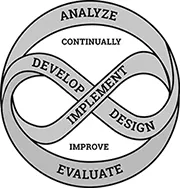
Streamlined ID
A Practical Guide to Instructional Design
- 426 pages
- English
- ePUB (mobile friendly)
- Available on iOS & Android
About this book
Streamlined ID presents a focused and generalizable approach to instructional design and development – one that addresses the needs of ID novices as well as practitioners in a variety of career environments. Highlighting essentials and big ideas, this guide advocates a streamlined approach to instructional design: producing instruction that is sustainable, optimized, appropriately redundant, and targeted at continuous improvement.
The book's enhanced version of the classic ADDIE model (Analysis, Design, Development, Implementation, and Evaluation) emphasizes the iterative nature of design and the role of evaluation throughout the design/development process. It clearly lays out a systematic approach that emphasizes the use of research-based theories, while acknowledging the need to customize the process to accommodate a variety of pedagogical approaches.
This thoroughly revised second edition reflects recent advances and changes in the field, adds three new chapters, updates reference charts, job aids, and tips to support practitioners working in a variety of career environments, and speaks more clearly than ever to ID novices and graduate students.
Frequently asked questions
- Essential is ideal for learners and professionals who enjoy exploring a wide range of subjects. Access the Essential Library with 800,000+ trusted titles and best-sellers across business, personal growth, and the humanities. Includes unlimited reading time and Standard Read Aloud voice.
- Complete: Perfect for advanced learners and researchers needing full, unrestricted access. Unlock 1.4M+ books across hundreds of subjects, including academic and specialized titles. The Complete Plan also includes advanced features like Premium Read Aloud and Research Assistant.
Please note we cannot support devices running on iOS 13 and Android 7 or earlier. Learn more about using the app.
Information

CHAPTER 1
THE ITERATIVE DESIGN PROCESS
- Businesses with changing products, services, competitors, and business conditions;
- Governments struggling to ensure an adequate quality of life for their citizenry, while adjusting to changing economic, political, and societal factors;
- Military organizations faced with global political changes, and new technologies and methods for securing populations;
- Institutions of higher learning tasked with anticipating and communicating an evolving knowledge base and meeting the changing needs of society, students, and future employers;
- Health care organizations challenged by changing health needs, demands for research, the application of new knowledge, and the implementation of new methods; and
- K-12 educators who must not only learn new knowledge and methods, but must also prepare future generations to learn and adapt in a constantly changing world.
- Analyze problems to determine if instruction is a valid solution;
- Identify and limit the scope of instruction to ensure its relevance and ability to meet critical needs;
- Select appropriate media and delivery modes; and
- Develop, implement, and evaluate the success of instruction.

INQUIRING MINDS WANT TO KNOW …
- Where did the field of Instructional Design and Technology originate?
- What constitutes an effective learning experience?
- How do you determine if your instructional solutions were effective?
- What factors and processes are involved in designing instruction, and how can the process be streamlined?
- What do you need to remember and understand from this chapter?







THE NATURE OF LEARNING AND INSTRUCTION

EFFECTIVE LEARNING EXPERIENCES
- Captures and maintains the learner’s attention;
- Communicates the learning objectives (the knowledge, skills, and attitudes to be learned) and their relevance to the learner;
- Is matched to learner needs and characteristics;
- Provides opportunities for meaningful interaction with, and reflection on, the content;
- Emphasizes essential (need-to-know) knowledge and skills over nice-to-know information;
- Supports learners in organizing new knowledge and making connections to prior knowledge;
- Provides cues for recalling and recognizing important information;
- Provides meaningful activities that enable learners to practice applying the new knowledge and skills described in the learning objectives in authentic settings;
- Assesses the learner in a way that is consistent with the learning objectives and the learning activities used in the instruction;
- Provides an environment conducive to learning that is motivating, diverse, encourages self-directed learning, provides practice and feedback, and opportunities for collaboration and discussion; and
- Is flexible in nature to provide access and opportunities for all learners through multiple means of representation, multiple means of expression, and multiple means of engagement.
THE FIELD OF INSTRUCTIONAL DESIGN AND TECHNOLOGY
Table of contents
- Cover
- Half Title
- Title Page
- Copyright Page
- Dedication
- Table of Contents
- List of Tables
- This Book: At a Glance
- Acknowledgements
- 1.The Iterative Design Process
- Analyze
- Design
- Develop
- Implement
- Evaluate
- Appendix A: List of Streamlined ADDIE Process Steps
- Appendix B: Final Design Plan Blueprint Checklist
- Glossary
- References
- Index